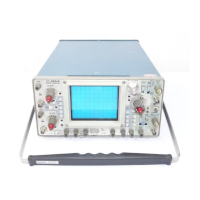Maintenance—
465B Service
8. CHECK INDIVIDUAL
COMPONENTS. TnefOllOW-
ing
procedures describe methods
of
checking
individual
components.
Components that are soldered in place
are
best checked
by disconnecting one end. This isolates
the
measurement from the effects of
surrounding circuitry.
WARNING
The Power switch
must he turned off before remov-
ing or replacing components.
Semiconductors.
A good check of transistor operation
is actual performance under
operating conditions. A
transistor can
be
most effectively
checked by substituting
a
new
component for it (or one which has been checked
previously). However,
be sure that circuit conditions
are
not such that a replacement transistor
might also be
damaged. If substitute transistors
are not available,
use a
dynamic tester. Static-type testers are
not recommended,
since
they do not check operation
under simulated
operating conditions.
When troubleshooting transistors
in the circuit with
a
voltmeter, measure
the
emitter-to-base
and emitter-to-
collector voltages
to determine if the voltages are consis-
tent with normal circuit voltage.
Voltages across
a
tran-
sistor vary with the type
of
device
and its circuit function.
Some of these voltages are predictable.
The emitter-to-
base voltage
of a conducting silicon transistor will normal-
ly be
0.6
to 0.8 volt. The emitter-to-collector
voltage of
saturated transistors is approximately
0.2 volt. Because
these values are
small, the best way to check them
is by
connecting the
voltmeter across the junction and
use a
sensitive
voltmeter setting.
This
method is preferable
to
comparing two voltages taken
with respect to ground
(both leads of the voltmeter must
be
isolated from ground,
if this method is used). If values less than these are
obtained, either the device is short-circuited or
no
current
is flowing in the circuit. If values are
in excess of the base-
emitter voltages given,
thejunction is back-biased or the
device is defective. Values in excess of those
given
for
emitter-collector
voltages could indicate either
a non-
saturated device operating normally, or
a
detective
(open-
circuited) transistor.
If the device is conducting, voltage
will be developed across resistances
in
series
with it; if it is
open, no voltage will
be developed
across
resistances in
series with
it
unless current
is
being
supplied
by a
parallel
path.
When
troubleshooting a field-effect transistor, the
voltage across its
elements can be checked in the same
manner
as
for
a transistor.
However,
it should be
remembered that in the normal depletion
mode of opera-
tion, the
gate-to-source junction is reverse biased; in the
enhanced mode, thejunction is forward biased.
Integrated circuits
(1C)
can be checked with a
voltmeter,
test oscilloscope, or by direct substitution. A
good understanding of circuit operation is essential to
troubleshooting circuits
using
1C.
Use care when check-
ing voltages and waveforms around the 1C so that adjacent
leads are not shorted together.
Typical
semiconductor
lead configurations
are shown at the beginning of the
Diagrams section.
Diodes. A diode can be checked for an open
or
a short
circuit
by
measuring the resistance between terminals
with an ohmmeter set to the R X Ik scale. The diode
resistance should be very high in one direction and very
low when the meter leads are reversed. Do not check
tunnel diodes
or back diodes with an
ohmmeter.
Do not use an
ohmmeter scale that has a
high
internal current.
High currents may damage the
diode. Do
not measure tunnel diodes
with an
ohmmeter; use
a
dynamic
tester (such as a
TEKTRONIX Type
576 Transistor-Curve
Tracer).
Checks on diodes
can
be
performed in much
the
same manner as on
transistor emitter-to-base ) unc-
tions. Silicon
diodes should have
0.6 to
0.8
volt
across the
/' unction when
conducting. Higher
readings indicate
that they are either
back
biased
or
defective, depending on polarity.
Resistors. Check the
resistors
with an ohmmeter.
Check the
Replaceable
Electrical Parts List for tolerance
of
the resistors
used in this instrument. Resistors normally
do not require replacement unless the measured value
varies
widely from the specified value.
Inductors. Check for open inductors by checking
continuity with an ohmmeter. Shorted or partially shorted
inductors
can usually befound by checking
the waveform
response when high-frequency signals are
passed
through
the circuit.
Capacitors. A leaky or shorted
capacitor
can best be
detected
by
checking resistance
with
an ohmmeter on the
highest scale. Do not exceed the voltage rating of the
capacitor. The resistance reading should be high after
initial charge
of
the
capacitor. An open
capacitor can
be
detected with a
capacitance
meter or
by
checking whether
the capacitor passes ac signals.
Attenuators. The
thick film attenuators
are best check-
ed by substitution. If only one channel of the 465B is not
operating properly, and there
is
reason to believe an
attenuator is defective, replace
the
suspected attenuator
5-10
REV A MAY 1980

